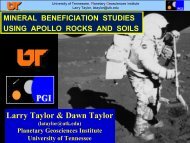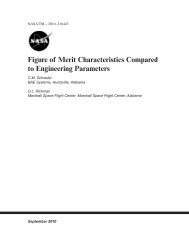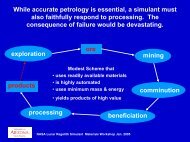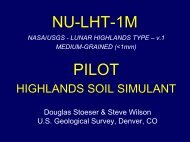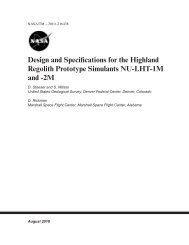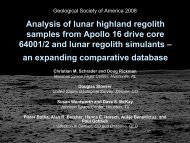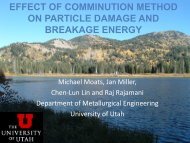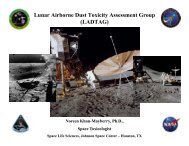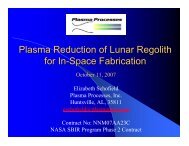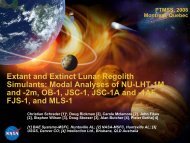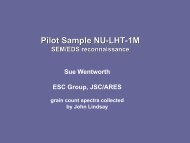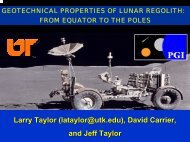Book of Abstracts- Lunar Regolith Simulant Materials Workshop
Book of Abstracts- Lunar Regolith Simulant Materials Workshop
Book of Abstracts- Lunar Regolith Simulant Materials Workshop
Create successful ePaper yourself
Turn your PDF publications into a flip-book with our unique Google optimized e-Paper software.
LUNAR REGOLITH SIMULANT REQUIREMENTS: MECHANICAL PROPERTIES<br />
CONSIDERATIONS. D. M. Cole 1 , S. Shoop 1 and P.T. Corcoran 2 ; 1 Engineer Research and Development Center –<br />
Cold Regions Research and Engineering Laboratory, 72 Lyme Rd.,Hanover, NH 03855, 2 Caterpillar Inc., Technical<br />
Center, P.O. Box 1875, Peoria, IL 61656-1875 (Contact: David.M.Cole@erdc.usace.army.mil).<br />
Introduction: Two upcoming projects under<br />
NASA’s HRT program address the characterization<br />
<strong>of</strong> the physical and mechanical properties <strong>of</strong> the<br />
regolith, and the development <strong>of</strong> regolith-handling<br />
construction equipment. Both efforts will require the<br />
use <strong>of</strong> a lunar regolith simulant to support the physical<br />
testing <strong>of</strong> a number <strong>of</strong> the regolith characterization<br />
instruments, and for testing prototypes or scale<br />
models <strong>of</strong> the regolith-handling equipment. The<br />
presentation outlines the physical and mechanical<br />
properties <strong>of</strong> a regolith simulant that are <strong>of</strong> greatest<br />
interest to these two projects, and gives some consideration<br />
to the quantities that will be required to support<br />
instrument testing and equipment development.<br />
Physical properties considerations: The<br />
physical properties considerations fall into the broad<br />
categories <strong>of</strong> individual particle characteristics,<br />
particle size distributions, and packing. For regolith<br />
that may be bonded (e.g., cemented by water ice, for<br />
example,) there are additional considerations related<br />
to the concentration <strong>of</strong> water and its distribution in<br />
the pore space. Although properties such as mineralogy<br />
and thermal characteristics are important in some<br />
applications, they are <strong>of</strong> secondary significance in the<br />
context <strong>of</strong> mechanical behavior (provided that the<br />
simulant is in roughly the same class as actual lunar<br />
material with respect to the cohesive/fracture strength<br />
<strong>of</strong> the particles and ice adhesion). The surface roughness<br />
and angularity <strong>of</strong> particles are key features <strong>of</strong><br />
lunar material that must be adequately relected in the<br />
simulant. These properties have a strong impact on<br />
the grain-scale mechanics <strong>of</strong> granular media, and<br />
hence on the material’s bulk behavior.<br />
Mechanical properties considerations: The<br />
needs <strong>of</strong> the HRT program encompass a broad spectrum<br />
<strong>of</strong> engineering problems that require knowledge<br />
<strong>of</strong> geotechnical and geophysical properties such as<br />
the effective elastic and dynamic moduli, and timedependent<br />
(e.g., creep) properties <strong>of</strong> the regolith.<br />
The design <strong>of</strong> equipment for drilling and excavating<br />
in the regolith, and handling excavated material for<br />
ISRU requires knowledge <strong>of</strong> frictional characteristics<br />
and granular media flow. Since detecting and<br />
recovering regolith that contains water ice is <strong>of</strong> prime<br />
concern, the mechanical properties <strong>of</strong> ice-bonded<br />
material are an issue as well.<br />
Characterization <strong>of</strong> the simulant: It will be important<br />
that the simulant used in any terrestrial prototype<br />
experiment not only provide an acceptable level<br />
<strong>of</strong> similitude with the lunar regolith, but also that the<br />
mechanical properties <strong>of</strong> the simulant be well understood<br />
and documented over a range <strong>of</strong> physical<br />
scales. Since it is anticipated that a strong emphasis<br />
will be placed on the use <strong>of</strong> either detailed numerical<br />
or perhaps physically based analytical models <strong>of</strong> the<br />
deformation processes <strong>of</strong> interest, it will be important<br />
to characterize the simulant in ways that adequately<br />
support the analytical efforts associated with the<br />
various experimental/testing activities <strong>of</strong> the overall<br />
program.<br />
It will be necessary to fully characterize the above<br />
mentioned physical properties <strong>of</strong> any simulant used<br />
in terrestrial testing. The mechanical properties<br />
characterizations should be considered on both the<br />
micro scale and the bulk or aggregate scale (e.g.,<br />
specimen sizes that are typical <strong>of</strong> geotechnical laboratory<br />
test-in). Additionally, it will be important to<br />
examine the bulk behavior over a range <strong>of</strong> relative<br />
densities and specimen preparation methods. Apart<br />
from supporting the critical testing <strong>of</strong> proposed instruments<br />
and equipment under realistic conditions,<br />
any testing conducted in well characterized simulant<br />
will add important information to the developing data<br />
base for the HRT program.<br />
The presentation covers the specific mechanical<br />
properties <strong>of</strong> interest in greater detail and describes<br />
the physical requirements for testing the proposed<br />
drilling system, and various surface and sub-surface<br />
geophysical and geomechanical testing instruments.<br />
29



